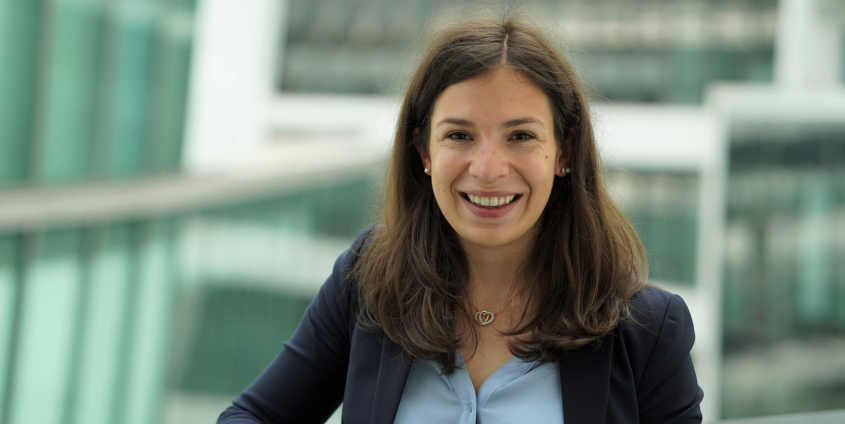Using mathematics and statistics to build a 3D image of a factory
The BMW Group production network comprises over 30 production sites worldwide. To date, there is no digital record of precisely where each machine is located or where a sprinkler system is suspended from the ceiling. As part of her doctoral thesis project, Christina Petschnigg headed to BMW in Munich to develop a methodology capable of implementing this digitalisation. She has now completed her doctoral studies and is putting her expertise to good use at Infineon in Villach.
“A laser scanner records point clouds that map the layout of the plants. With the help of mathematical models, so-called deep neural networks, we were able to recognise objects and then derive a simulation model automatically. Ultimately, we ended up with a 3D model of a BMW factory“, Christina Petschnigg describes her work, which has involved living in Munich for the past three and a half years.
The 3D models have many uses for production sites of this magnitude: If the factory is to be converted for the construction of a different car model, it is possible to simulate the conversion in advance and check whether it can be carried out efficiently. It is also possible to optimise production processes on the basis of these models.
A current weakness in this approach: At present, laser scanners have to be moved through the production halls manually and with great effort. “Right now, it takes a human being to generate the point clouds… But for the future I also asked myself: What conditions do we need within the factory so we can automate this step?”, she continues.
Christina Petschnigg was employed by BMW and supervised by Jürgen Pilz (Department of Statistics at the University of Klagenfurt). Subsequently, she moved to Villach, where she now works on supply chain digitalization at Infineon. “What can we read from machines? What are the stock levels? How can these be tracked more efficiently?”. These are the questions she is currently tackling.
Christina Petschnigg’s career path illustrates the diversity of the areas in which mathematics is applied. She completed both the Bachelor’s and Master’s degree programmes in Technical Mathematics in Klagenfurt. “When I came to university, I had a different idea of what to expect. In the end, my studies were more abstract. At first, I did not expect the huge range of opportunities that this offers. From finance to civil engineering, from physics to computer science: the career options are many,” she tells us.
What she likes most about mathematics is its logic: “Everything follows a logic, and nothing deviates from it. There are no exceptions. Once I have grasped something, I no longer need to memorise things. What really matters is your interest: If you don’t have that, all you see are Greek letters.” Christina Petschnigg was the first member of her family to pursue an academic education. She was involved in research projects in the field of IT from early on. While completing her Master’s degree, she worked at Joanneum Research in the field of robotics. Her principal interest lies in the field of applied research, which is why she was keen to take up the offer of an industrial doctorate at BMW. But “you only appreciate Carinthia once you have seen the disadvantages of a metropolis with millions of inhabitants. While you are still stuck in a traffic jam in Munich at 6 pm, you could already be enjoying a swim in a lake in Carinthia”, she concludes, having returned to Carinthia with international experience under her belt.
A few words with … Christina Petschnigg
Did you have a plan B for your education and what might that have looked like?
I didn’t really have a plan B, because I’ve always been interested in mathematics and physics.
Do your parents understand your work?
Yes, they often ask me about my work and also have a general understanding of what I do.
What’s the first thing you do when you get to the office in the morning?
I check my e-mails and Outlook calendar to see what the day has in store for me.
Do you have proper holidays? Without thinking about your work?
Yes, it’s the only way I can really relax and recharge my batteries.
Who do you regard as the greatest scientist in history, and why?
During my research I came across Katherine Johnson. I consider her to be an outstanding personality. She was one of the first African-American women scientists at NASA and, among other things, she calculated the trajectory for Apollo 11’s moon mission. We should bear in mind that access to higher education was particularly difficult for women and African-Americans at that time. Defying all odds, she received numerous awards for her outstanding scientific achievements.
What makes you furious?
Incomprehensible instruction manuals.
And what calms you down?
Extensive hikes and spending time at the lake.
Why do so many people fear mathematics?
I think mathematics can appear very abstract when you struggle to understand the underlying set of rules.
What are you looking forward to?
Spending time with my family.
Study mathematics in Klagenfurt
For many, it is the most elegant language in the world, because it is unambiguous: mathematics. It helps us to describe and solve our day-to-day problems. Today, mathematics is a key technology and an indispensable basis for the development of technical innovations. We are looking for clever minds who are good at detecting patterns and structures in apparent chaos and who enjoy tackling tricky issues! Find out now!










 Foto: KK
Foto: KK
